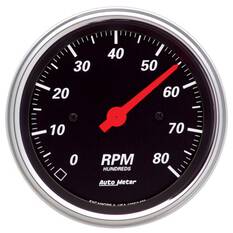The Importance of a Tachometer in Monitoring Engine Rate and Performance in Automotive Applications
In the realm of auto engineering, the tachometer stands as a crucial instrument in the vehicle driver's arsenal, giving a direct home window right into the internal workings of a lorry's engine. Beyond its feature as a plain gauge of revolutions per min (RPM), the tachometer serves as a critical tool for lovers and specialists alike, providing real-time insights right into engine efficiency and health. Comprehending the value of this device exceeds surface-level monitorings, diving right into the intricate connection in between engine rate, power output, and general driving experience. As we check out the multifaceted function of the tachometer in auto applications, a deeper gratitude for its effect on vehicle dynamics and effectiveness begins to arise.
Importance of Keeping Track Of Engine RPM
Checking engine RPM, or revolutions per minute, is a crucial element of vehicle maintenance and efficiency analysis. Engine RPM straight associates with the rate at which the engine's crankshaft revolves, showing just how rapidly the engine is running.
In addition, keeping track of engine RPM is crucial for performance examination in auto racing and high-performance cars. In recap, checking engine RPM is not only important for identifying issues yet additionally for optimizing engine performance in different auto applications.

Benefits of Real-Time Data
In vehicle applications, real-time information plays a crucial role in offering immediate insights into the performance and condition of the car. By constantly keeping an eye on different specifications such as engine rate, temperature, fuel consumption, and much more, real-time data offers numerous benefits that add to boosted performance and safety and security when driving.
One substantial benefit of real-time information is its capability to alert chauffeurs and professionals to any abnormalities or issues promptly. This positive approach makes it possible for quick recognition of potential problems, permitting timely interventions to stop additional damage or breakdowns. In addition, real-time information assists in performance optimization by giving prompt responses on driving routines and engine efficiency. Drivers can readjust their habits in real-time based on this details to achieve better gas other economic climate and prolong the life-span of their automobile.

In addition, real-time data plays an essential role in contemporary automotive diagnostics, allowing technicians to swiftly detect and address breakdowns. This leads to minimized downtime, reduced maintenance expenses, and inevitably, improved general automobile dependability and durability (tachometer). By using the power of real-time data, vehicle stakeholders can make enlightened decisions that positively impact both the performance and durability of the lorry
Effect On Gear Shifts
The tachometer plays a crucial role in optimizing equipment shifts by providing real-time engine speed information to the vehicle driver. When approaching the redline on the tachometer, it signals the vehicle driver to upshift to protect against over-revving the engine and creating potential damages.
In addition, the tachometer help in accomplishing smoother gear transitions, particularly in hand-operated transmissions. By monitoring engine rate, vehicle drivers can carry out gear shifts at the optimum RPM array, hop over to these guys minimizing jerking motions and lessening wear on the transmission components. This accuracy on duty modifications not only boosts driving comfort but likewise adds to fuel performance.
Enhancing Fuel Efficiency
Offered the important role the tachometer plays in maximizing equipment shifts for efficiency and engine health, it straight adds to taking full advantage of fuel performance in auto applications. By providing real-time responses on engine speed, the tachometer aids motorists in maintaining one of the most efficient RPM array for fuel economic situation. When chauffeurs consistently check the tachometer and change their motoring practices as necessary, they can avoid unnecessary gas usage triggered by over-revving or carrying the engine.
In addition, the tachometer assists motorists determine the most fuel-efficient equipment to be in at any given moment, stopping the engine from functioning harder than needed. In verdict, the tachometer offers as a useful device in improving gas effectiveness by advertising optimal driving practices and identifying areas for improvement in the car's performance.

Making The Most Of Engine Durability
The tachometer's function in monitoring engine i was reading this speed and performance is crucial in making sure the long life of auto engines. Monitoring the tachometer allows drivers to stay within the recommended RPM array for their car, preventing unnecessary pressure on the engine and extending its lifespan.

Verdict
To conclude, the tachometer plays an important role in keeping track of engine rate and performance in automotive applications. By giving real-time data on RPM, it permits for reliable gear shifts, improved fuel efficiency, and taken full advantage of engine longevity. This tool is crucial for keeping ideal engine efficiency and making certain the total performance of a vehicle.